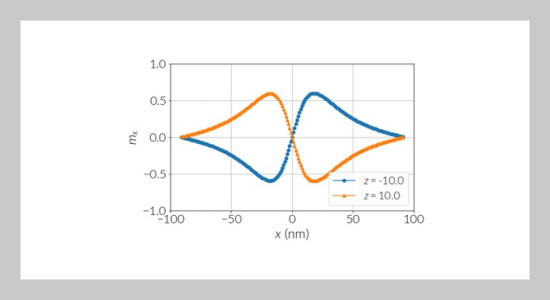REFERENCES
- [1] Shawn D Pollard, Joseph A Garlow, Jiawei Yu, Zhen Wang, Yimei Zhu, and Hyunsoo Yang. Observation of stable Néel skyrmions in cobalt/palladium multilayers with Lorentz transmission electron microscopy. Nature communications, 8(1):1–8, 2017.
- [2] J Cui, Y Yao, X Shen, Y G Wang, and R C Yu. Artifacts in magnetic spirals retrieved by transport of intensity equation (TIE). Journal of Magnetism and Magnetic Materials, 454:304–313, 2018.
- [3] Senfu Zhang, Junwei Zhang, Yan Wen, Eugene M Chudnovsky, and Xixiang Zhang. Determination of chirality and density control of Néel-type skyrmions with inplane magnetic field. Communications Physics, 1(1):1–7, 2018.
- [4] K Karube, J S White, N Reynolds, J L Gavilano, H Oike, A Kikkawa, F Kagawa, Y Tokunaga, Henrik M Rønnow, and Y Tokura. Robust metastable skyrmions and their triangular–square lattice structural transition in a high-temperature chiral magnet. Nature materials, 15(12):1237–1242, 2016.
- [5] Peter Milde, Denny Köhler, Joachim Seidel, L M Eng, Andreas Bauer, Alfonso Chacon, Jonas Kindervater, Sebastian Mühlbauer, Christian Pfleiderer, and Stefan Buhrandt. Unwinding of a skyrmion lattice by magnetic monopoles. Science, 340(6136):1076–1080, 2013.
- [6] Markus Hoffmann, Bernd Zimmermann, Gideon P Müller, Daniel Schürhoff, Nikolai S Kiselev, Christof Melcher, and Stefan Blügel. Antiskyrmions stabilized at interfaces by anisotropic Dzyaloshinskii-Moriya interactions. Nature communications, 8(1):1–9, 2017.
- [7] Kai Litzius, Ivan Lemesh, Benjamin Krüger, Pedram Bassirian, Lucas Caretta, Kornel Richter, Felix Büttner, Koji Sato, Oleg A Tretiakov, and Johannes Förster. Skyrmion Hall effect revealed by direct time-resolved X-ray microscopy. Nature Physics, 13(2):170–175, 2017.
- [8] Sabpreet Bhatti, Rachid Sbiaa, Atsufumi Hirohata, Hideo Ohno, Shunsuke Fukami, and S N Piramanayagam. Spintronics based random access memory: a review. Materials Today, 20(9):530–548, 2017.
- [9] Riccardo Tomasello, E Martinez, Roberto Zivieri, Luis Torres, Mario Carpentieri, and Giovanni Finocchio. A strategy for the design of skyrmion racetrack memories. Scientific reports, 4:6784, 2014.
- [10] P Lai, G P Zhao, H Tang, N Ran, S Q Wu, J Xia, X Zhang, and Y Zhou. An improved racetrack structure for transporting a skyrmion. Scientific reports, 7:45330, 2017.
- [11] Raí M Menezes, Jeroen Mulkers, Clécio C de Souza Silva, and Milorad V Miloševi´c. Deflection of ferromagnetic and antiferromagnetic skyrmions at heterochiral interfaces. Physical Review B, 99(10):104409, 2019.
- [12] Kyoung-Whan Kim, Kyoung-Woong Moon, Nico Kerber, Jonas Nothhelfer, and Karin Everschor-Sitte. Asymmetric skyrmion Hall effect in systems with a hybrid Dzyaloshinskii-Moriya interaction. Physical Review B, 97(22):224427, 2018.
- [13] Riccardo Tomasello, E Martinez, Roberto Zivieri, Luis Torres, Mario Carpentieri, and Giovanni Finocchio. A strategy for the design of skyrmion racetrack memories. Scientific reports, 4:6784, 2014.
- [14] Ivan Lemesh, Felix Büttner, and Geoffrey S D Beach. Accurate model of the stripe domain phase of perpendicularly magnetized multilayers. Physical Review B, 95(17):174423, 2017.
- [15] Xichao Zhang, Jing Xia, Yan Zhou, Daowei Wang, Xiaoxi Liu, Weisheng Zhao, and Motohiko Ezawa. Control and manipulation of a magnetic skyrmionium in nanostructures. Physical Review B, 94(9):94420, 2016.
- [16] Ajaya K Nayak, Vivek Kumar, Tianping Ma, Peter Werner, Eckhard Pippel, Roshnee Sahoo, Franoise Damay, Ulrich K Rößler, Claudia Felser, and Stuart S P Parkin. Magnetic antiskyrmions above room temperature in tetragonal Heusler materials. Nature, 548(7669):561–566, 2017.
- [17] Ales Hrabec, Joao Sampaio, Mohamed Belmeguenai, Isabell Gross, Raphael Weil, Salim Mourad Chérif, A Stashkevich, Vincent Jacques, Andre Thiaville, and Stanislas Rohart. Current-induced skyrmion generation and dynamics in symmetric bilayers. Nature communications, 8(1):1–6, 2017.
- [18] Tianli Jin, Durgesh Kumar, Weiliang Gan, Mojtaba Ranjbar, Feilong Luo, Rachid Sbiaa, Xiaoxi Liu, Wen Siang Lew, and S N Piramanayagam. Nanoscale compositional modification in Co/Pd multilayers for controllable domain wall pinning in racetrack memory. physica status solidi (RRL)–Rapid Research Letters, 12(10):1800197, 2018.
- [19] Albert Fert, Nicolas Reyren, and Vincent Cros. Magnetic skyrmions: advances in physics and potential applications. Nature Reviews Materials, 2(7):1–15, 2017.
- [20] A Kurenkov, C Zhang, S DuttaGupta, S Fukami, and H Ohno. Device-size dependence of field-free spinorbit torque induced magnetization switching in antiferromagnet/ferromagnet structures. Applied Physics Letters, 110(9):92410, 2017.
















